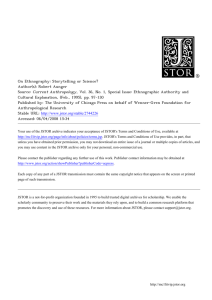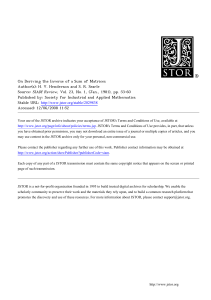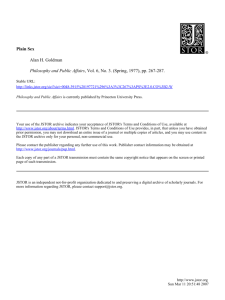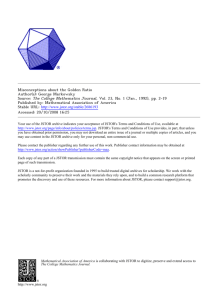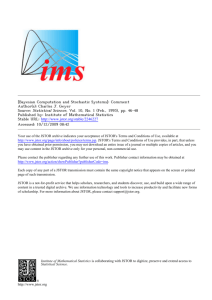Discovering New Product Opportunities with Problem Inventory
advertisement
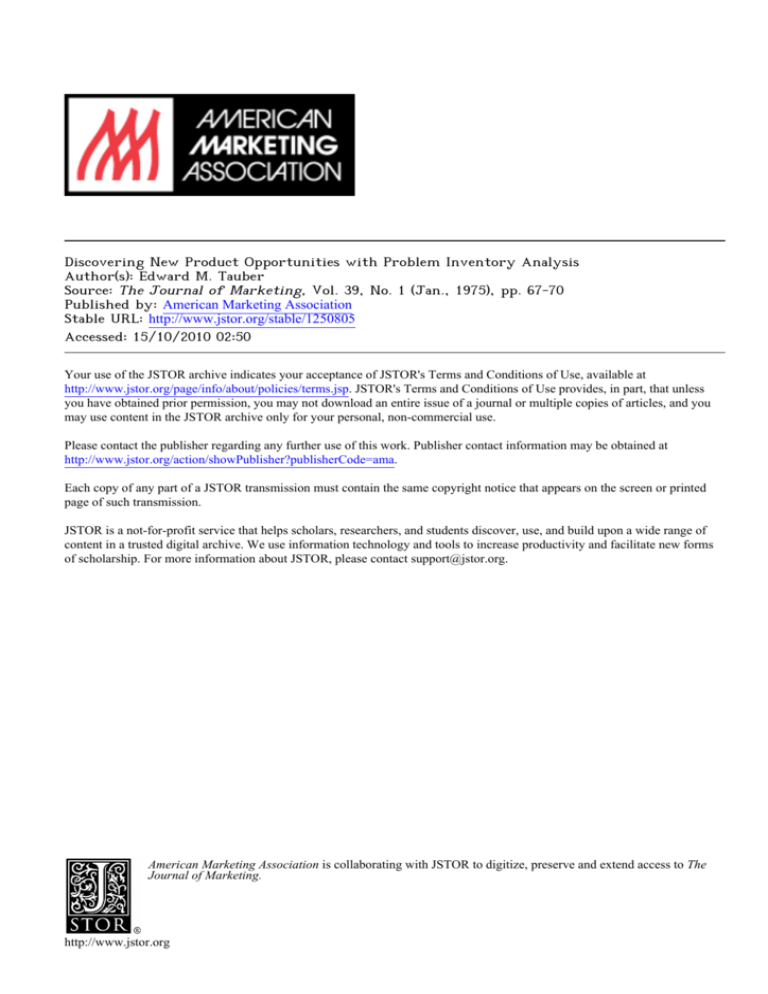
Discovering New Product Opportunities with Problem Inventory Analysis Author(s): Edward M. Tauber Source: The Journal of Marketing, Vol. 39, No. 1 (Jan., 1975), pp. 67-70 Published by: American Marketing Association Stable URL: http://www.jstor.org/stable/1250805 Accessed: 15/10/2010 02:50 Your use of the JSTOR archive indicates your acceptance of JSTOR's Terms and Conditions of Use, available at http://www.jstor.org/page/info/about/policies/terms.jsp. JSTOR's Terms and Conditions of Use provides, in part, that unless you have obtained prior permission, you may not download an entire issue of a journal or multiple copies of articles, and you may use content in the JSTOR archive only for your personal, non-commercial use. Please contact the publisher regarding any further use of this work. Publisher contact information may be obtained at http://www.jstor.org/action/showPublisher?publisherCode=ama. Each copy of any part of a JSTOR transmission must contain the same copyright notice that appears on the screen or printed page of such transmission. JSTOR is a not-for-profit service that helps scholars, researchers, and students discover, use, and build upon a wide range of content in a trusted digital archive. We use information technology and tools to increase productivity and facilitate new forms of scholarship. For more information about JSTOR, please contact support@jstor.org. American Marketing Association is collaborating with JSTOR to digitize, preserve and extend access to The Journal of Marketing. http://www.jstor.org MarketingNotes and Communications 67 of economic scarcity. Such changes can be expected in government policy, consumer behavior, competition, and in the development of a psychology of scarcity. To survive in this new business environment, firms must develop new, responsive marketing strategies. Important among these are reconsideration of the product mix, modifications in price policy, changes in promotional and advertising strategy, and developments in channel management. Long-range planning under conditions of scarcity, however, may require consideration and implementation of more comprehensive strategies such as: inventing backwards; demonstrating social awareness in pricing, employment, and com- Discovering New Opportunitieswith Inventory petitive practices; more aggressive market research and intelligence work to anticipate future changes; awareness of the firm's contribution not only to the economy but to the society as a whole; and the possibilities for converting shortages into new product opportunities. Current indications are that conditions of scarcity will be an integral part of the American business environment for many months and possibly years to come. To maintain and improve his company's position under these conditions, the effective marketer must be aware of the total environment and develop marketing strategies to respond to it progressively and productively. Product Problem Edward M. Tauber Analysis Howproductsand services improvethe qualityof life-a basis for seeking new products. DENTIFYINGnew product opportunities is a major task for most corporations. Forecasting new opportunities has traditionally taken two different approaches: (1) technology forecasting (the supply side), and (2) need forecasting (the demand side). Marketing has emphasized the latter method, which is directed at the question "What should we make?" rather than "What can we make?" The marketing concept advocates that a business start with a consumer need and work backwards to develop a product and the means of manufacturing and distribution to best fit this need.1 While this is sound in theory, marketers have long realized the difficulty of measuring consumer needs. Most consumers are generally unable to relate what needs they have. Open-end questioning about needs rarely provides useful guidelines for product development. Instead, the more common procedure is to generate new product ideas somewhat ad hoc and then test consumer response to these ideas. 1. Theodore Levitt, "Marketing Myopia," Harvard Business Review, Vol. 38 (July-August 1960), pp. 55-68. The traditional approach to new product search, which begins with creative sessions to generate ideas, relies on judgment and research to find a market for the proposed products. Much of the marketing literature on idea generation has reflected this orientation.2 Early efforts to systematize the search process dealt mainly with schemes to enhance creativity. Alex Osborn's technique of brainstorming is a device to harness group creativity through specified rules of operation-the desire for free wheeling, combination and improvement, quantity of ideas, and deferred judgment.3 A variant of brainstorming, synectics, uses various methods to encourage detachment, specula2. See Tony Lantis, "How to Generate New Product Ideas," Journal of Advertising Research, Vol. 10 (June 1970), pp. 31-35; E. Patrick McGuire, Generating New-Product Ideas, report no. 546, The Conference Board, New York, 1972; Edward M. Tauber, "HIT: Heuristic Ideation Technique-A Systematic Procedure for New Product Search," JOURNAL OF MARKETING, Vol. 36 (January 1972), pp. 58-70; and Dik Warren Twedt, "How to Plan New Products, Improve Old Ones, and Create Better Advertising," JOURNAL OF MARKETING,Vol. 33 (January 1969), pp. 53-57. 3. Alex F. Osborn, Applied Imagination: Principles and Procedures of Creative Thinking (New York: Scribners, 1953). 68 Journal of Marketing,January 1975 tion, and deferred judgment from the participants. According to its chief proponent, George Prince, synectics is a "structured approach to problem solving."4 The critical point is that these pioneering techniques focused on solving problems. As psychologists affirm, "creative activity appears simply to be a special class of problem solving activity characterized by novelty, unconventionality and persistence."5 But to solve a problem, one must have a problem! When that problem is something as general as "the company needs new product ideas," any creative approach applied to solve it will resemble a fishing expedition. What is necessary to increase the odds of success for such efforts is a well-defined consumer problem. In contrast to the techniques discussed above, which have problem solution as their objective, problem inventory analysis has the objective of problem discovery, the unearthing of consumer needs or problems. though consumers are involved, the sample size of the typical focus group is too small to permit generalization of the findings. Therefore, some researchers attempt to quantify the breadth and intensity of the problems or needs identified in the focus group by having larger projectable samples react to these problems/needs.' This type of research provides an estimate of the size of the market segments concerned about the various problems. Idea generation is then directed to identify products that would solve these problems. The key to the success of this approach is the discovery of some meaningful problems in the exploratory focus group phase, because later research only quantifies the degree to which these exist for the rest of the population. Thus, this method relies on consumers to tell their needs and problems in unstructured interviews, an unreliable technique at best. ProblemDiscovery:Background The technique proposed in this article is the reverse of that discussed above. Rather than presenting the consumer with a product or category and asking her/him to identify problems, problem inventory analysis provides the consumer with a list of problems and asks for each what products come to mind as having that problem. This procedure is based on two assumptions: 1. The general ways in which products and services can improve the quality of life are rather limited. 2. It is much easier for consumers to relate known products to suggested problems than to generate problems for a given product. If the narrow definition of the marketing concept as a customer orientation is to be expanded to encompass the broader commitment of improving the quality of life as perceived by consumers, then some dialogue is needed about general ways that products and services can accomplish this objective. For example, products and services can make work tasks easier, reduce the time necessary for completing tasks, provide safety from harm, make movement more efficient, provide entertainment, and so on. Considerable work remains, but the checklist here (Table 1) provides a beginning. In developing a problem inventory for a particular industry category, the author found that the number of problems identified was rather limited. For example, in the food industry an attempt to develop an exhaustive list of problems resulted in a total of only 134 (Table 2). A modification of brainstorming-reverse brainstorming-was developed by the Hotpoint Company.6 Rather than attempt to generate new ideas or solutions as with brainstorming, reverse brainstorming had the objective of taking a particular product (e.g., refrigerators) and generating a list of things that were wrong with it. This list of negatives thus provided direction for product improvement. The limitation of this approach was that the problems were ones perceived by management or other employees who participated in the brainstorming sessions. There was no indication of whether these were the important problems as perceived by consumers. Probably the most common approach currently used for identifying problems or needs is the focus group, an extension of reverse brainstorming with some improvement. A group of consumers is brought together to discuss problems, negatives, or usage habits of a product category. However, al4. George M. Prince, The Practiceof Creativity(New York: Harper& Row, 1970), p. 45. 5. Allen Newell, J. C. Shaw, and HerbertA. Simon, "The Processes of CreativeThinking,"in Contemporary Approaches to Creative Thinking,H. Gruber, ed. (New York: Atherton Press, 1962), p. 66. 6. John W. Haefele, Creativityand Innovation(New York: Reinhold PublishingCo., 1962), p. 145. * ABOUT THEAUTHOR. Edward M. Tauber is assistant professor of marketing in the School of Business Administration,the University of Southern California. ProblemInventoryAnalysis 7. For example, "ProblemDetection Studies,"developedby BBDO, Inc., New York, N.Y. MarketingNotes and Communications 69 TABLE1 SOMEWAYSTHATPRODUCTS ANDSERVICES CAN IMPROVE THEQUALITY OFLIFE 1. 2. 3. 4. 5. 6. 7. 8. 9. 10. 11. 12. 13. 14. 15. 16. 17. 18. 19. 20. Provideprotectionfrom the elements Improveliving environment Make work tasks easier Provideentertainment Be relaxingor stimulating Reduce time necessary for completing tasks Facilitatesport, competition, or challenge Make movement more efficient (transport) Cure illnesses and their symptoms and results (pain/death) Providesafety from harm Improveor extend the senses (sight, hearing, touch, etc.) Facilitatecreativityor self-expression Reduce confusion or complexity Provideknowledge, information,or insights Contributeto order or organization Extendmemory (e.g., recordings) Providestorage Satisfy physical needs (hunger, thirst, sleep, exercise, etc.) Enableor improvecommunication Afford status/prestige Once the list of problems is obtained, the research phase is initiated. A list of statements is prepared, each of which mentions a problem but not a product; for example, "Preparing leaves so many pots to clean." In a selfadministered survey, respondents are asked to fill in the blanks. In effect, this method is a form of (sentence completion), projective technique whereby consumers are asked to indicate the product that immediately comes to mind given a specified problem. Illustrationin the Food Industry To demonstrate the use of problem inventory analysis, a study conducted in the food industry is presented here. Twenty-five problem statements were selected and put in questionnaire form to be self-administered by a sample of housewives. Professional interviewers contacted 200 women in intercept fashion in shopping centers throughout the country (five cities). A number of rotations of the problem statements were used to minimize any order effects. Table 3 shows the results of the tabulated data. Cautions Clearly, the results of a problem inventory analysis must be interpreted cautiously. Certain "stock" or "expected" answers may be given that do not represent true opportunities. For example, 49% of the respondents in this study mentioned cereal as a package that does not fit well on the shelf. General Foods obviously took the bait and introduced their "compact" cereal box, which eventually misfired. This "problem" must be of relatively little importance to consumers. Another example: while 16% of the sample believe "it's difficult to get catsup to pour easily," it TABLE 2 SOME EXAMPLES OF CONSUMER PROBLEMS RELATING TO FOOD Physiological A. Weight -fattening -empty calories B. Hunger -filling -still hungry after eating C. Thirst -doesn't quench thirst -makes one thirsty D. Health -indigestion -bad for teeth -keeps one awake -acidity Activities Sensory A. Taste -bitter -bland -salty B. Appearance -color -unappetizing -shape C. Consistency/ Texture -tough -dry -greasy D. Decomposition -melts -spoils -separatesoven A. Meal planning -forget -get tired of it B. Storage -run out -package won't fit C. Preparation -too many pots/pans -never turns out D. Cooking -sticks Buyingand Usage A. Portability A. -eat away from home -take in a carried lunch B. Portioncontrol B. -not enough in a package -creates leftovers leftovprepared C. Availability -out of season -not in supermarket C. D. Spoilage -gets moldy E. Cleaning -makes a mess in -smells in refrigerator E. Cost -expensive -takes expensive ingredients Psychological/Social Serve to company -won't serve to guests -too much lastminute preparation Eatingalone -effort when I cook for myself -depressing when just one for Self-image by a lazy -macook -not served by served by -not a good mother 70 Journal of Marketing,January 1975 TABLE 3 RESULTS OF A PROBLEM INVENTORY STUDY ABOUT FOOD Questions Asked and % of Respondents Answering 1. The package of doesn't fit well on the shelf. cereal flour 49% 6% 2. My husband/children refuse to eat liver 18% vegetables spinach 5% 4% soft drinks milk coffee 58% 9% 6% 3. doesn't quench my thirst. 4. Packaged fast enough. jello/gelatin doesn't dissolve 32% bouillon cubes 8% pudding 5% Conclusion 5. Everyone always wants different vegetables 23% cereal 11% meat 10% desserts 9% 6. makes a mess in the oven. broiling steaks 19% 17% 8% pie roast/pork/rib 7. Packaged instant potatoes tastes artificial. 12% macaroni and cheese 4% 8. It's difficult to get easily. to pour 16% 13% catsup syrup gallon of milk 11% 9. Packaged hamburgerhelper 6% lunch meat 3% liver looks unappetizing. 3% 10. I wish my husband/children could take in a carriedlunch. hot meal soup 11% 9% ice cream 4% is likely that few would accept a thin, watery product. These examples demonstrate that results from a problem inventory analysis should be used primarily as clues for further investigation. Any product problem identified should be studied in depth to determine what percentage of the population has the problem and with what level of intensity. Problems surviving this screening may then be pursued. It is at this stage that idea sessions or techniques can offer creative problem solutions. While certain answers to a problem inventory may not reflect true opportunity, care must be taken to avoid discarding out-of-hand problems where past solutions have failed or where the more obvious solutions probably would. For example, while product reformulation was not an acceptable solution to the pourability problem of catsup (above), the problem may still offer opportunity (e.g.) with changes in package shape or flexibility. Marketers have always appreciated the logic of beginning a new product search with a customer problem. The difficulty of identifying such problems, however, continues to plague the researcher. An investigation into the ways that products and services can improve the quality of life represents one method for proceeding. The resulting problem inventory can then be presented to consumers to determine what products, activities, and the like, have these problems. The implicit assumption in problem inventory analysis is that consumers will recognize problems or needs they have. Admittedly, major innovations and the need for them are often beyond the foresight of masses of people.8 Still, even in mature industries, many consumer problems do exist and are rather easily recognized. The difficulty is that solutions are not obvious or necessarily simple. It is easier to proliferate a minor product-variation than to solve a consumer problem. The latter often takes more time, technology, and money. Yet the effort may be worth it. Since problem-solution communication is relatively straightforward, new products that result as solutions to identified problems are more easily advertised and more likely to be successful. 8. Edward M. Tauber, "How Market Research Discourages Major Innovation," Business Horizons, Vol. 17 (June 1974), p. 25.

